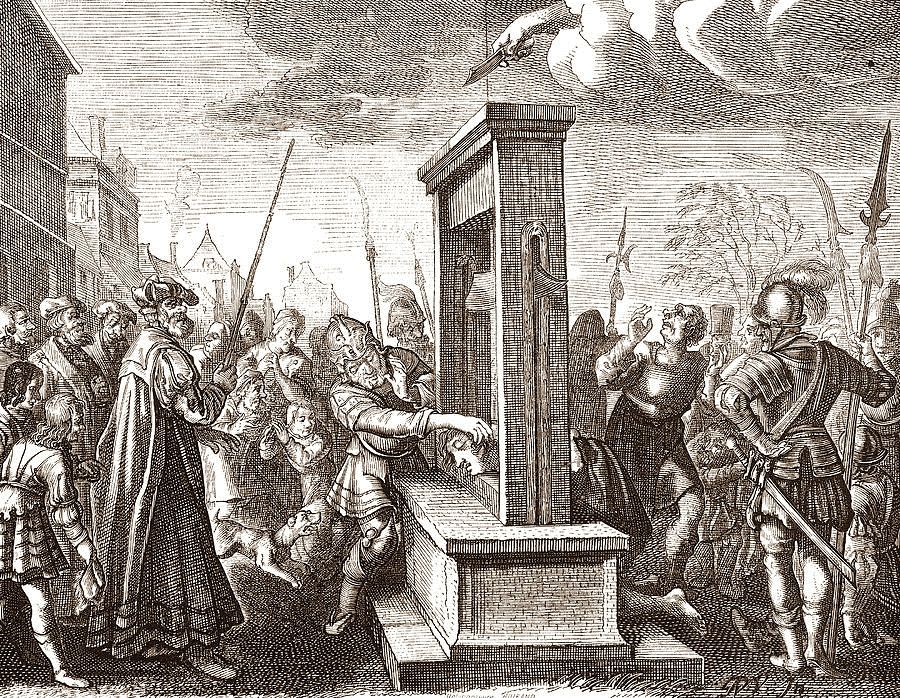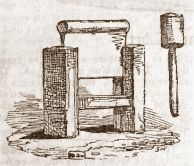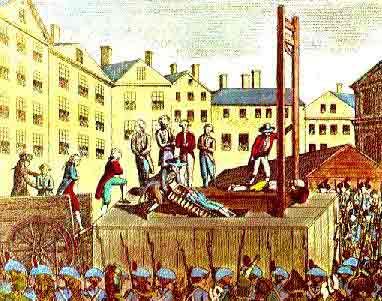You may speak of the Halifax Gibbet and the Scottish Maiden but when it comes to noodle-knapping there is really only one name in
the frame – Doctor Joseph-Ignace Guillotin. The question is, Why? The popular
imagination loves poetic justice and just as the tale of James Douglas, 4th
Earl of Morton, tells how he was the first and last man to be decapitated by
his own invention, the Scottish Maiden, (when, in fact, he was nothing of the
sort), so the story goes that Doctor Guillotin invented the eponymous Guillotine
and was sent to meet his maker by means of his own device. Except, that isn’t
true either. The good Doctor neither invented the machine that bears his name
nor was he killed by it. He died of natural causes at the grand old age of
seventy-five in 1814. And he was opposed to the death penalty, too. That’s
where the real story begins.
 |
| An early precursor of the Guillotine |
During the years prior to the French Revolution,
the citizens of France began to voice their discontent with the Ancien
Régime, not least regarding the brutality and barbarity of the forms of
capital punishment employed in the Kingdom. The aristocrats were despatched by
either the sword or the axe, which was not always a clean cut and there are
numerous reports of two or more strokes being needed, descending at times into
down-right hacking off the head. The common folk were hanged, burnt or broken
on the wheel, amongst other ways, and it was decided that a more humane,
egalitarian method of execution was required. King Louis XVI banned the
practice of breaking on the wheel, in a nod to the sentiment, but this was not
enough.
 |
| Off with their heads |
As the Revolution got underway, Dr Guillotin, who proposed various
changes to the methods of capital punishment, addressed a meeting of the
National Assembly. A committee was established, under Antoine Louis (the King’s
physician and Secretary to the Academy of Surgery), and Guillotin was a member
of this committee. He supported the idea of a method of execution that would be
used for everyone, regardless of class or position, but his own position was that
this would be the first step in the total abolition of the death penalty. The
prototype of the beheading machine was designed by Louis, based on the idea of
Halifax Gibbet and the Scottish Maiden, together with early devices used in
Germany and Italy, where it was called the mannaja.
 |
| A very early head-removing block |
John Evelyn, the
English diarist, describes this,
“The next day, I saw a wretch executed, who had murdered his master, for which he had his head chopped off by an ax that slid down a frame of timber, between the two tall columns in St. Mark's piazza, at the sea-brink; the executioner striking on the ax with a beetle; and so the head fell off the block.”Evelyn also notes,“At Naples they use a frame, like ours at Halifax.”
Louis employed Tobias Schmidt, a German
engineer and harpsichord maker, to build the prototype and it was Schmidt who
suggested the refinement of using a slanted, triangular blade with a bevelled
edge. The Halifax and Scottish devices used a horizontal blade that not so much
sliced off the head as punched it away from the body by brute force.
 |
| The French chopping tetes off |
On March
25th 1792, the National Assembly passed a recommendation that the
machine, then known as a Louisette, be adopted in prisons across the
country and it was first used on April 25th 1792, when a highwayman,
Nicolas Jacques Pélletier, was beheaded in Paris. There was a feeling that the Louisette
was simply too quick and denied the crowd the thrill of former executions, but
soon it was the only form of execution permitted in France (other than firing
squads in military cases). However, the zeal with which Guillotin advocated the
use of the Louisette lead to his own name becoming associated with the
machine, and a chance remark he made at a follow-up meeting of the National
Assembly,
“Now, with my machine, I cut off your head in the twinkling of an eye, and you never feel it,”
resulted in his little quip being taken up
across Paris – there was even a comic song written about it. Soon, the Louisette
was known instead as the Guillotine, and the name has stuck ever since. The
guillotine was used extensively during the Reign of Terror, when thousands lost
their lives, including King Louis XVI and his Queen, Marie Antoinette, and at
one stage even Dr Guillotin was arrested and faced execution, although he was
released when Robespierre was overthrown.
 |
| Off their heads ... |
Coincidentally, another doctor, Dr J
B V Guillotin of Lyons, was beheaded on February 28th 1794 and this
may be the source of the tale that puts the other Dr Guillotin to the blade,
“J. B. V. Guillotine, M.D., formerly of Lyons, was among the multitude of persons who have lately been executed there. He was charged with having corresponded with persons at Turin.”[Annual Register, 1794, vol 37]
The
Guillotin family sought to distance their name from the machine and pressed the
French government to rename it, but their request was refused and so, with
typical Gallic ingenuity, the family changed their surname instead.
 |
| Marie Antoinette loses her head |
No comments:
Post a Comment